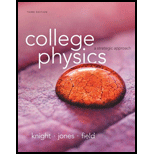
College Physics: A Strategic Approach (3rd Edition)
3rd Edition
ISBN: 9780321902559
Author: Randall D. Knight (Professor Emeritus), Brian Jones, Stuart Field
Publisher: PEARSON
expand_more
expand_more
format_list_bulleted
Concept explainers
Textbook Question
Chapter 20, Problem 29MCQ
A positive charge is brought near to a dipole, as shown in Figure Q20.29. If the dipole is free to rotate, it
Figure Q20.29

A. Begins to rotate in a clockwise direction.
B. Begins to rotate in a counterclockwise direction.
C. Remains stationary.
Expert Solution & Answer
Want to see the full answer?
Check out a sample textbook solution
Students have asked these similar questions
No chatgpt pls will upvote
No chatgpt pls will upvote
No chatgpt pls will upvote
Chapter 20 Solutions
College Physics: A Strategic Approach (3rd Edition)
Ch. 20 - Four lightweight balls A, B, C, and D are...Ch. 20 - Plastic and glass rods that have been charged by...Ch. 20 - a. Can an insulator be charged? If so, how would...Ch. 20 - When you take clothes out of the drier right after...Ch. 20 - The positive charge in Figure Q20.5 is +Q. What is...Ch. 20 - As shown in Figure Q20.6, metal sphere A has 4...Ch. 20 - Figure Q20.7 shows a positively charged rod held...Ch. 20 - A plastic balloon that has been rubbed with wool...Ch. 20 - You are given two metal spheres on portable...Ch. 20 - A honeybee acquires a positive electric charge as...
Ch. 20 - A metal rod A and a metal sphere B, on insulating...Ch. 20 - Iontophoresis is a noninvasive process that...Ch. 20 - A 10 nC charge sits at a point in space where the...Ch. 20 - A hollow soda straw is uniformly charged, as shown...Ch. 20 - A positively charged particle is in the center of...Ch. 20 - Two charged particles are separated by 10 cm....Ch. 20 - A small positive charge q experiences a force of...Ch. 20 - A typical commercial airplane is struck by...Ch. 20 - Microbes such as bacteria have small positive...Ch. 20 - a. Is there a point between a 10 nC charge and a...Ch. 20 - Two lightweight, electrically neutral conducting...Ch. 20 - All the charges in Figure Q20.23 have the same...Ch. 20 - All the charges in Figure Q20.241Q have the same...Ch. 20 - All the charges in Figure Q20.25 have the same...Ch. 20 - A glass bead charged to +3.5 nC exerts an 8.0 104...Ch. 20 - A +7.5 nC point charge and a 2.0 nC point charge...Ch. 20 - Three point charges are arranged as shown in...Ch. 20 - A positive charge is brought near to a dipole, as...Ch. 20 - A glass rod is charged to +5.0 nC by rubbing. a....Ch. 20 - A plastic rod is charged to 20 nC by rubbing. a....Ch. 20 - Prob. 3PCh. 20 - A plastic rod that has been charged to 15.0 nC...Ch. 20 - A glass rod that has been charged to +12.0 nC...Ch. 20 - Two identical metal spheres A and Bare in contact....Ch. 20 - Two identical metal spheres A and Bare connected...Ch. 20 - If two identical conducting spheres are in...Ch. 20 - Two 1.0 kg masses are 1.0 m apart on a...Ch. 20 - A small metal sphere has a mass of 0.15 g and a...Ch. 20 - A small plastic sphere with a charge of 5.0 nC is...Ch. 20 - A small metal bead, labeled A, has a charge of 25...Ch. 20 - A small glass bead has been charged to +20 nC. A...Ch. 20 - What are the magnitude and direction of the...Ch. 20 - In Figure P20.15, charge q2 experiences no net...Ch. 20 - Object A, which has been charged to +10 nC, is at...Ch. 20 - A small glass bead has been charged to +20 nC....Ch. 20 - What magnitude charge creates a 1.0 N/C electric...Ch. 20 - What are the strength and direction of the...Ch. 20 - A 30 nC charge experiences a 0.035 N electric...Ch. 20 - What are the strength and direction of the...Ch. 20 - A +1 0 nC charge is located at the origin. a. What...Ch. 20 - A 10 nC charge is located at the origin. a. What...Ch. 20 - What are the strength and direction of the...Ch. 20 - What are the strength and direction of the...Ch. 20 - What are the strength and direction of an electric...Ch. 20 - A 0.10 g plastic bead is charged by the addition...Ch. 20 - A parallel-plate capacitor is constructed of two...Ch. 20 - A parallel-plate capacitor is formed from two 4.0...Ch. 20 - Two identical closely spaced circular disks form a...Ch. 20 - A parallel-plate capacitor is constructed of two...Ch. 20 - Storm clouds may build up large negative charges...Ch. 20 - A neutral conducting sphere is between two...Ch. 20 - One kind of e-book display consists of millions of...Ch. 20 - A protein molecule in an electrophoresis gel has a...Ch. 20 - Large electric fields in cell membranes cause ions...Ch. 20 - Molecules of carbon mon-oxide are permanent...Ch. 20 - A 2.0-mmdiameter copper ball is charged to +50 nC....Ch. 20 - Pennies today are copper-covered zinc, but older...Ch. 20 - Two protons are 2.0 fm apart. (1 fm= 1 femtometer...Ch. 20 - The nucleus of a 12Xe atom (an isotope of the...Ch. 20 - Two equally charged, 1.00 g spheres are placed...Ch. 20 - Objects A and Bare both positively charged. Both...Ch. 20 - An electric dipole is formed from 1.0 nC point...Ch. 20 - What are the strength and direction of the...Ch. 20 - What are the strength and direction of the...Ch. 20 - What is the force on the 1.0 nC charge in Figure...Ch. 20 - What is the force on the 1.0 nC charge in Figure...Ch. 20 - What is the magnitude of the force on the 1.0 nC...Ch. 20 - What are the magnitude and direction of the force...Ch. 20 - As shown in Figure P20.52, a 5.0 nC charge sits at...Ch. 20 - Two particles have positive charges q and Q. A...Ch. 20 - Model a pollen grain as a sphere of carbon 0.10 mm...Ch. 20 - In a simple model of the hydrogen atom, the...Ch. 20 - A 0.10 g honeybee acquires a charge of +23 pC...Ch. 20 - Two 2.0-cm-diameter disks face each other, 1.0 mm...Ch. 20 - The electron gun in a television tube uses a...Ch. 20 - A 0.020 g plastic bead hangs from a lightweight...Ch. 20 - A 4.0 mg bead with a charge of 2.5 nC rests on a...Ch. 20 - Two 3.0 g spheres on 1.0-m-long threads repel each...Ch. 20 - An electric field E = (100,000 N/C, right) causes...Ch. 20 - An electric field E = (200,000 N/C, right) causes...Ch. 20 - A small charged bead has a mass of 1.0 g. It is...Ch. 20 - A bead with a mass of 0.050 g and a charge of 15...Ch. 20 - A small bead with a positive charge q is free to...Ch. 20 - A parallel-plate capacitor consists of two plates,...Ch. 20 - If the charging collar has a positive charge, the...Ch. 20 - Which of the following describes the charges on...Ch. 20 - Because the droplets are conductors, a droplet's...Ch. 20 - Another way to sort the droplets would be to give...
Additional Science Textbook Solutions
Find more solutions based on key concepts
Low-pressure centers are also referred to as ______, while high-pressure centers are called ______.
Applications and Investigations in Earth Science (9th Edition)
8. A human maintaining a vegan diet (containing no animal products) would be a:
a. producer
b. primary consume...
Human Biology: Concepts and Current Issues (8th Edition)
List all the different gametes that are possible from the following genotypes. a. AABbCcDd b. AabbCcDD c. AaBbC...
Genetic Analysis: An Integrated Approach (3rd Edition)
2. Define equilibrium population. Outline the conditions that must be met for a population to stay in genetic e...
Biology: Life on Earth (11th Edition)
Distinguish between microevolution, speciation, and macroevolution.
Campbell Essential Biology (7th Edition)
Describe an example of bioconversion. What metabolic processes can result in fuels?
Microbiology: An Introduction
Knowledge Booster
Learn more about
Need a deep-dive on the concept behind this application? Look no further. Learn more about this topic, physics and related others by exploring similar questions and additional content below.Similar questions
- No chatgpt plsarrow_forwardhelp me with the experimental set up for the excel i did. the grapharrow_forwardWhich of the following best describes how to calculate the average acceleration of any object? Average acceleration is always halfway between the initial acceleration of an object and its final acceleration. Average acceleration is always equal to the change in velocity of an object divided by the time interval. Average acceleration is always equal to the displacement of an object divided by the time interval. Average acceleration is always equal to the change in speed of an object divided by the time interval.arrow_forward
- The figure shows the velocity versus time graph for a car driving on a straight road. Which of the following best describes the acceleration of the car? v (m/s) t(s) The acceleration of the car is negative and decreasing. The acceleration of the car is constant. The acceleration of the car is positive and increasing. The acceleration of the car is positive and decreasing. The acceleration of the car is negative and increasing.arrow_forwardWhich figure could represent the velocity versus time graph of a motorcycle whose speed is increasing? v (m/s) v (m/s) t(s) t(s)arrow_forwardUnlike speed, velocity is a the statement? Poisition. Direction. Vector. Scalar. quantity. Which one of the following completesarrow_forward
- No chatgpt pls will upvote Already got wrong chatgpt answerarrow_forward3.63 • Leaping the River II. A physics professor did daredevil stunts in his spare time. His last stunt was an attempt to jump across a river on a motorcycle (Fig. P3.63). The takeoff ramp was inclined at 53.0°, the river was 40.0 m wide, and the far bank was 15.0 m lower than the top of the ramp. The river itself was 100 m below the ramp. Ignore air resistance. (a) What should his speed have been at the top of the ramp to have just made it to the edge of the far bank? (b) If his speed was only half the value found in part (a), where did he land? Figure P3.63 53.0° 100 m 40.0 m→ 15.0 marrow_forwardPlease solve and answer the question correctly please. Thank you!!arrow_forward
arrow_back_ios
SEE MORE QUESTIONS
arrow_forward_ios
Recommended textbooks for you
 Principles of Physics: A Calculus-Based TextPhysicsISBN:9781133104261Author:Raymond A. Serway, John W. JewettPublisher:Cengage Learning
Principles of Physics: A Calculus-Based TextPhysicsISBN:9781133104261Author:Raymond A. Serway, John W. JewettPublisher:Cengage Learning Physics for Scientists and Engineers with Modern ...PhysicsISBN:9781337553292Author:Raymond A. Serway, John W. JewettPublisher:Cengage Learning
Physics for Scientists and Engineers with Modern ...PhysicsISBN:9781337553292Author:Raymond A. Serway, John W. JewettPublisher:Cengage Learning College PhysicsPhysicsISBN:9781285737027Author:Raymond A. Serway, Chris VuillePublisher:Cengage Learning
College PhysicsPhysicsISBN:9781285737027Author:Raymond A. Serway, Chris VuillePublisher:Cengage Learning
 College PhysicsPhysicsISBN:9781938168000Author:Paul Peter Urone, Roger HinrichsPublisher:OpenStax College
College PhysicsPhysicsISBN:9781938168000Author:Paul Peter Urone, Roger HinrichsPublisher:OpenStax College Physics for Scientists and Engineers, Technology ...PhysicsISBN:9781305116399Author:Raymond A. Serway, John W. JewettPublisher:Cengage Learning
Physics for Scientists and Engineers, Technology ...PhysicsISBN:9781305116399Author:Raymond A. Serway, John W. JewettPublisher:Cengage Learning

Principles of Physics: A Calculus-Based Text
Physics
ISBN:9781133104261
Author:Raymond A. Serway, John W. Jewett
Publisher:Cengage Learning

Physics for Scientists and Engineers with Modern ...
Physics
ISBN:9781337553292
Author:Raymond A. Serway, John W. Jewett
Publisher:Cengage Learning

College Physics
Physics
ISBN:9781285737027
Author:Raymond A. Serway, Chris Vuille
Publisher:Cengage Learning


College Physics
Physics
ISBN:9781938168000
Author:Paul Peter Urone, Roger Hinrichs
Publisher:OpenStax College

Physics for Scientists and Engineers, Technology ...
Physics
ISBN:9781305116399
Author:Raymond A. Serway, John W. Jewett
Publisher:Cengage Learning
Electric Fields: Crash Course Physics #26; Author: CrashCourse;https://www.youtube.com/watch?v=mdulzEfQXDE;License: Standard YouTube License, CC-BY